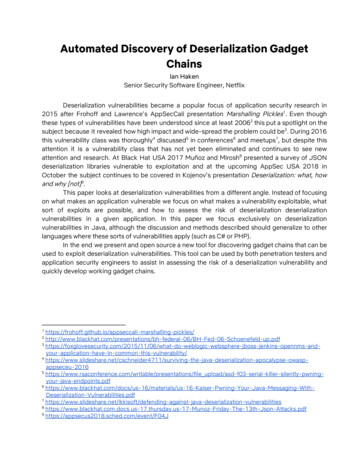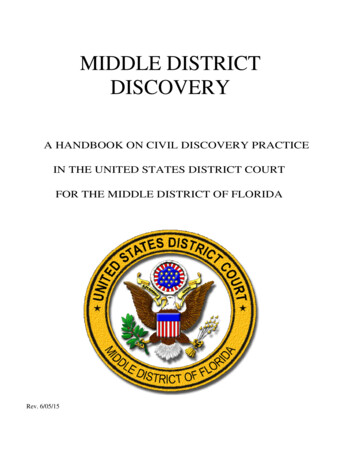
Transcription
Automated Discovery of Deserialization GadgetChainsIan HakenSenior Security Software Engineer, NetflixDeserialization vulnerabilities became a popular focus of application security research in2015 after Frohoff and Lawrence’s AppSecCali presentation Marshalling Pickles1. Even thoughthese types of vulnerabilities have been understood since at least 20062 this put a spotlight on thesubject because it revealed how high impact and wide-spread the problem could be3. During 2016this vulnerability class was thoroughly4 discussed5 in conferences6 and meetups7, but despite thisattention it is a vulnerability class that has not yet been eliminated and continues to see newattention and research. At Black Hat USA 2017 Muñoz and Mirosh8 presented a survey of JSONdeserialization libraries vulnerable to exploitation and at the upcoming AppSec USA 2018 inOctober the subject continues to be covered in Kojenov’s presentation Deserialization: what, howand why [not]9.This paper looks at deserialization vulnerabilities from a different angle. Instead of focusingon what makes an application vulnerable we focus on what makes a vulnerability exploitable, whatsort of exploits are possible, and how to assess the risk of deserialization deserializationvulnerabilities in a given application. In this paper we focus exclusively on deserializationvulnerabilities in Java, although the discussion and methods described should generalize to otherlanguages where these sorts of vulnerabilities apply (such as C# or PHP).In the end we present and open source a new tool for discovering gadget chains that can beused to exploit deserialization vulnerabilities. This tool can be used by both penetration testers andapplication security engineers to assist in assessing the risk of a deserialization vulnerability andquickly develop working gadget chains.h ckles/h /BH-Fed-06-Schoenefeld-up.pdf3h logic-websphere-jboss-jenkins-opennms-and /4h -the-java-deserialization-apocalypse-owasp appseceu-20165h s/file upload/asd-f03-serial-killer-silently-pwning your-java-endpoints.pdf6h -Kaiser-Pwning-Your-Java-Messaging-With Deserialization-Vulnerabilities.pdf7h st-java-deserialization-vulnerabilities8h Munoz-Friday-The-13th-Json-Attacks.pdf9h ttps://appsecus2018.sched.com/event/F04J12
What is a deserialization vulnerability?In object oriented languages such as Java, data can be contained in classes. The power ofobject oriented languages is that semantic behavior related to these classes is carried with thedata. This affects the design of software in these languages and also allows for powerful featureslike polymorphism. The fundamental vulnerability caused by deserialization is that an attacker mayspecify the t ype of the data being being passed in to an application as it is deserialized. Becausethe type of data specifies the class instantiated to hold that data—and the class determines whatcode might be run—this means the attacker has direct influence on what code gets executed.Consider the following Java snippet which represents a web application with a classic Javadeserialization vulnerability.@POSTpublic String renderUser(HttpServletRequest request) {ObjectInputStream ois new ObjectInputStream(request.getInputStream());User user (User) ois.readObject(); return user.render();}The developer’s intent is that the request body contains a serialized version of the followingUser class, which will get deserialized by the ObjectInputStream.readObject() method andcast to U ser . Suppose the implementation of the U ser class looks something like the below:public class User implements Serializable { private String name ; public String render() { return name ;}}In this case an attacker being able to control the name field reflected in the output of theweb request is benign. While the developer can control the data type returned fromois.readObject() , it is cast to a User and therefore the attacker cannot meaningfully influencewhat code is executed without further context. However, suppose the following class also exists inthe application.
public class ThumbnailUser extends User { private File thumbnail ; public String render() { return Files. read ( thumbnail );}}If the attacker instead sends a serialized instance of ThumbnailUser then when theapplication calls render() on the object the contents of any file on the filesystem may bereflected to the attacker. This demonstrates how an attacker being able to specify the type of dataallows the attacker to induce unintended behavior.Gadget ChainsIf this were the extent of the danger of deserialization vulnerabilities it would likely be thecase that most vulnerabilities are not exploitable since it relies on applications implementingclasses with “dangerous behavior” that override the benign behavior of the intended data types.However, many deserialization libraries (including Java’s ObjectInputStream ) utilize m agicmethods so that classes can control their serialization/deserialization behavior. Magic methods getautomatically invoked by the deserialization library even before returning from the readObject()method. Therefore, if any class on the classpath implements dangerous behavior inside a magicmethod, it can be executed by an attacker regardless of what type the object is cast to inside ofapplication code.An example of a class implementing such a magic method is the JDK’sjava.util.HashMap . If this class used default serialization mechanics then serialized instancesof the class would likely not be interoperable between JDK versions when the underlyingimplementation of the hash map was altered. To improve interoperability, this class insteadimplements the writeObject() / readObject() methods which the deserialization libraryinvokes instead of using the default scheme for serializing / deserializing objects. When writing outa map the writeObject() magic method instead just serializes all key/value pairs as a list. Whenreading in a map the readObject() magic method reads each key/value pair from the list andcalls this.put(key, value) for each pair. As a result this class will also call hashCode() andequals() on each key read out of the serialized payload.Thus, if any class on the classpath implements dangerous behavior inside one ofhashCode() or equals() it’s possible to construct a serialized payload that would execute thatmethod. This gives rise to the notion of a gadget chain . A gadget chain is a sequence of classmethods starting with one of these magic methods and where the invocation of one method in thechain leads to the invocation of the next method in the chain, ultimately ending with some sort ofdangerous behavior.Consider the following example classes based on a simplified gadget chain in Clojure (whichis described in greater detail below):
class AbstractTableModel ff19274a { private IPersistentMap clojureFnMap ; public int hashCode() {IFn f clojureFnMap .get( "hashCode" ); return (int)(f.invoke( this ));}}public class FnCompose implements IFn { private IFn f1 , f2 ; public Object invoke(Object arg) { return f2 .invoke( f1 .invoke(arg));}}public class FnConstant implements IFn { private Object value ; public Object invoke(Object arg) { return value ;}}public class FnEval implements IFn { public Object invoke(Object arg) { return Runtime.exec(arg);}}By composing instances of these classes into a serialized payload and then wrapping theAbstractTableModel ff19274a instance in a HashMap , an attacker can execute arbitrarycode. This is an example of such a serialized payload using Jackson-style serialization:{“@class”: “java.util.HashMap”“members”: [2,{“@class”: “AbstractTableModel ff19274a”“ clojureFnMap”: {“hashCode”: {“@class”: “FnCompose”“f2”: { “@class”: “FnConstant”, “value”: “/usr/bin/calc” } , “f1”: { “@class”: “FnEval” }}}}, “val”]}If this payload were converted to ObjectInputStream ’s binary format and sent to thevulnerable renderUser() endpoint described in the first section, the application would end upinvoking the /usr/bin/calc process before ever returning from the readObject() method.Since this happens before readObject() returns, it is irrelevant that the returned value (aHashMap ) cannot be cast to User .There are many classes besides HashMap in the JDK (and other common Java libraries)that implement magic methods and therefore provide useful first links in gadget chains. Another
example is the java.util.PriorityQueue class which can invoke Comparator.compare()and Comparable.compareTo() methods of its members. The ysoserial project10 is a collectionof deserialization gadget chains which includes many other examples.The most important thing to observe about gadget chains is there their construction iscompletely unrelated to what code or libraries your application invokes. Instead it is onlyconstrained by what classes are available on the classpath of your application. If your applicationincludes some library (perhaps even transitively) that is never actually called, its classes can still beused to build a gadget chain.Finding Deserialization VulnerabilitiesFinding deserialization vulnerabilities is similar to finding many other web applicationsvulnerabilities such as cross-site scripting (XSS) or SQL injection. In the simplest terms anapplication is vulnerable if attacker-controlled data (such as a query parameter or request body)flows into a vulnerable method (such as new ObjectInputStream(attackerData).readObject() ). While new “vulnerable methods” are being discovered by researchers such asthe JSON libraries enumerated by Muñoz and Mirosh, the mechanisms by which vulnerabilities arefound in applications are reasonably well understood. We will therefore omit discussion on thistopic and refer the reader to aforementioned presentations and discussions of deserializationvulnerabilities.Why Focus on Exploits instead of RemediationGiven the assertion that we understand how to find deserialization vulnerabilities it isreasonable to ask why we would focus on exploit discovery and development rather thanremediation. However, remediating a deserialization vulnerability can be particularly difficultbecause it involves modification of the communication layer between an application and its clients.It some cases, it can be extremely difficult or even impossible to change the communicationmechanism used by clients. Consider the case that client code is deployed on embedded orconsumer electronic (CE) devices. In this case there may be many clients that are years or evendecades old that cannot be updated. However, even if both client and server components areunder developer control it is still often a costly and difficult migration to perform. Developers musteither ensure that no breaking changes are made to the existing communication protocol or elseprovide an upgrade path to a new communication protocol and coordinate migration of all clients.Given that there can be significant costs to changing the communication layer of a service itthen becomes important to understand the trade-offs. If an application has a deserializationvulnerability but has a small classpath with no gadget chains it may not be worth spending the timeand effort needed to fully remediate the vulnerability. On the other hand, a vulnerability that issubject to a remote code execution (RCE) exploit would usually be prioritized. Thus, informationabout what gadget chains can be constructed can help inform the priority of remediation.10h ttps://github.com/frohoff/ysoserial
Ultimately what would be useful to get a contextual understanding of what risk a deserializationvulnerability poses when it is discovered.Existing Gadget Chain ToolsSeveral tools do already exist to assist to help discover gadget chains on an application’sclasspath. The ysoserial project11 is one of the most well-known ones. It contains some tools forbuilding gadget chain payloads and has a collection of gadget chains discovered by researchers inopen source libraries. Therefore if an application has one of these libraries on the classpath one canalmost immediately identify possible gadget chains. However, this repository is not itself a tool forfinding new gadget chains, gadget chains that can be constructed using a c ombination of libraries,or gadget chains exploitable against deserialization libraries other than the JDK’sObjectInputStream library. Marshalsec12 is a similar project which supports a wider breadth ofdeserialization libraries, but is again a tool which largely includes known gadget chains. The JavaDeserialization Scanner13 is a Burp Suite plugin which dynamically scans applications and attemptsto utilize known gadget chains from the ysoserial project. The NCC Group Burp Plugin14 is anotherBurp Suite plugin but which is mainly based on the JSON payloads from Muñoz and Mirosh’s work.In contrast, joogle15 is a tool for performing programmatic queries against class and methodmetadata of a classpath. This is a useful tool for researchers attempting to construct a gadget chainone link at a time. However, using joogle to construct a gadget chain is still a largely manualprocess.Requirements for a new Gadget Chain ToolGiven that our simply stated goal is to understand the risk of a deserialization vulnerability,we would like to construct a new tool that can illuminate what gadget chains can be constructedagainst an application’s classpath. Therefore we would like a tool that: Determines what gadget chain exploits exist on the classpath Determines the impact of those exploits (e.g. RCE, SSRF, DoS, etc) Provides a (limited) overestimation of impact rather than underestimation Easily operates on the entire classpath of an application; given multiple source languages(such as Groovy, Scala, Clojure, Kotlin, etc) it should operate on Java bytecode Understands different deserialization libraries and the restrictions on gadget chains thatmay be imposed by each libraryh ttps://github.com/frohoff/ysoserialh ttps://github.com/mbechler/marshalsec13h v ulnerabilities/14h -events/blog/2018/june/finding-deserialisationi on-killer/15h ttps://github.com/Contrast-Security-OSS/joogle1112
Gadget InspectorThe primary contribution of this paper is the introduction of a tool satisfying the aboverequirements. We have named this tool Gadget Inspector and it is available as an open sourceproject16.This tool operates on a classpath and supports specifying either a war (in order to analyze awhole web application) or a collection of jars (for analyzing a single library and its transitivedependencies or just an alternatively constructed application). The output of the tool is a list ofgadget chains where each gadget chain is a list of method invocations. Some examples of theseoutputs and corresponding gadget chain payloads are provided below.Gadget Inspector makes a number of simplifying assumptions to make analysis of the Javabytecode relatively straightforward. These assumptions are laid out in the details below and weattempt to justify each assumption to explain why they are expected to lead to a low number oferrors in the analysis.As an example of a gadget chain produced by Gadget Inspector, the following is one of thefirst results discovered from this tool:1.2.3.4.5.clojure.inspector.proxy javax.swing.table.AbstractTableModel ff19274a.hashCode() (0)clojure.main load script.invoke(Object) (1)clojure.main load script.invokeStatic(Object) (0)clojure.lang.Compiler.loadFile(String) (0)FileInputStream. init (String) (1)This gadget chain causes the application to load (and execute) a clojure source file fromdisk. By changing the fourth method invocation in this gadget chain to clojure.main eval optwe can actually achieve arbitrary RCE instead. This version of the gadget chain was added to theysoserial project in July 201717 and its full construction can be seen there. A condensed form ofthis construction is provided here for illustration:1617h h c/main/java/ysoserial/payloads/Clojure.java
final String clojurePayload String. format ( "(use '[clojure.java.shell :only [sh]]) (sh %s)" , cmd);Map String, Object fnMap new HashMap String, Object ();fnMap.put( "hashCode" , new clojure.core comp().invoke( new clojure.main eval opt(), new clojure.core eModel ff19274a model new AbstractTableModel ff19274a();model. initClojureFnMappings(PersistentArrayMap. create( fnMap));HashMap Object, Object targetMap new HashMap Object, Object ();targetMap.put(model, null );return targetMap;How Gadget Inspector WorksGadget Inspector is open source18 and the reader is encouraged to inspect the source codefor low level details of its operation. Gadget Inspector primarily utilizes the ASM library19 for Javabytecode inspection and builds upon its instruction visitor framework to perform symbolicexecution. It operates in five major steps which we describe below.Class and Method Hierarchy EnumerationThe first step is enumerating all of the classes, methods, and their metadata for classes onthe classpath. Using this we also build up a class inheritance hierarchy and method overridehierarchy.This step could be easily accomplished using JDK reflection APIs although we utilize ASMto inspect class files directly since it is used more deeply below anyway.Passthrough Dataflow DiscoveryThe next step is discover methods with “passthrough” dataflow. Specifically we want toenumerate cases where an argument X to method M being attacker-controllable leads to anattacker-controllable object being returned from M. We achieve this by stepping through bytecodeand performing some simple symbolic execution. Consider the following two examples:1819h h ttps://asm.ow2.io/
public class FnConstant implements IFn { private Object value ; public Object invoke(Object arg) { return value ;}}public class FnDefault { private FnConstant f ; public Object invoke(Object arg) { return arg ! null ? arg : f .invoke(arg);}}This would lead to the following output. Note that arguments are numbered starting at 0and that for all non-static methods (such as both above) the implicit this argument is argument 0. FnConstant.invoke() - 0 FnDefault.invoke() - 1 FnDefault.invoke() - 0In the first bullet above we are indicating that if the 0th argument to FnConstant.invoke() isattacker-controlled then we expect the return value to be attacker-controlled. This is because theoutput of that invocation is this.value . This leads us to our first assumption: if an object isattacker-controllable then all fields of that object are also attacker-controllable. We justify thisgiven the context of our threat model. If an object is attacker-controlled it’s usually because it isread from a serialized payload and thus all of its members are also set from the serializationpayload. There are cases where this assumption may break down, but in evaluation it doesn’t leadto many false positives.In the second bullet above we indicate that the 1st argument to FnDefault.invoke()gets returned. In the third bullet, if the this argument to FnDefault.invoke() isattacker-controllable then by our above assumption we assume this.f is alsoattacker-controllable. Given the first bullet above, we therefore assume that the return value ofthis.f.invoke() is attacker-controllable. Therefore we finally see that the return value wouldalso be attacker-controllable.Implicit in our derivation of bullets two and three is another assumption: any branchconditions inside methods are satisfiable. Determining what branch conditions are satisfiable tendsto be one of the more difficult problems in code analysis which is entirely side-stepped by this tool.We feel justified in making this assumption since very often the variables used to make branchdecisions are also attacker-controllable and therefore an attacker has strong control over whatbranch conditions get satisfied. Although this is one of the weaker justifications, based on theevaluation of Gadget Inspector (discussed more below) this led to few false positives.The results of this step of the analysis are only used to aid in the next step.Passthrough Callgraph DiscoveryThe next step in Gadget Inspector’s operation is very similar to the previous one. However,instead of enumerating dataflow from method arguments to return values, we instead want toenumerate dataflow from method arguments to method invocations. This is used to build up a callgraph for the application. This is achieved using the same symbolic execution as above. Thefollowing is an example:
public class AbstractTableModel ff19274a { private IPersistentMap clojureFnMap ; public int hashCode() {IFn f clojureFnMap .get( "hashCode" ); return (int)(f.invoke( this ));}}This method would result in the following output for the AbstractTableModel ff19274a.hashCode() method: 0 - IFn.invoke() @ 1 0 - IFn.invoke() @ 0In the first bullet we are indicating that if the 0th argument to hashCode() (the implicitthis ) is attacker-controllable then this gets passed in as the 1st argument to IFn.invoke() . Toderive the second bullet, if we treat this as attacker-controllable then clojureFnMap isattacker-controllable. As a heuristic we treat Map.get() as having passthrough dataflow on the0th argument. Therefore we determine that f is attacker-controllable. We then see f passed as theimplicit this to f .invoke() . This yields the second bullet above.Gadget Chain Source DiscoveryUsing the class and method hierarchy from the first step, in this step we enumerate allgadget chain source methods. These methods are enumerated using known tricks discovered byresearchers. For example, we treat Object.hashCode() as a source method since we know thatthis method can get invoked by putting the object in a HashMap as described above. While theexample of the hashCode() entry point could be derived using the rest of Gadget Inspector’sanalysis, other entry points rely on a hardcoded configuration. One example of this is theInvocationHandler.invoke() entry point utilized by Frohoff’s commons-collections gadgetchain, which can be achieved by wrapping the class in a dynamic proxy. Gadget Inspector wouldhave been unable to derive this gadget chain source method on its own since it relies on theunderlying JDK behavior of dynamic proxies which bytecode analysis would not reveal.What source methods exist may also depend on what serialization library we areconsidering. The above examples are valid for the JDK’s ObjectInputStream , but for otherlibraries (such as Jackson) entry points would vary. For Jackson, the source methods may just beno-arg constructors.Call Graph SearchGiven the call graph from step 3 and the source methods from step 4, we now simplyperform a breadth-first-search through the call graph starting from those source methods. We
output a gadget chain whenever the search encounters an “interesting method.” Each node in thecall graph is a method invocation such as “0 - IFn.invoke() @ 1”. At each node we add to oursearch all implementations of those methods (using the method hierarchy enumerated in step 1).For the example of “0 - IFn.invoke() @ 1” we would add all implementations of IFn.invoke() asfurther nodes to explore in our graph search. Given the above examples, this would includeFnConstant.invoke() and FnDefault.invoke() .The ability to jump to any method implementation is another assumption of our analysis. Ingeneral this is possible because the attacker controls the data types of any fields of objects in ourgadget chain and therefore what implementation of a class is deserialized as that field value. Theonly limitation on this assumption is that an attacker can only specify data types that areserializable. The conditions that make a class serializable depend on what serialization library weare considering, which is another one of the ways Gadget Inspector is parameterizable.It is important to note that we output a gadget chain result once we encounter an“interesting method.” It is another limitation that this analysis requires a hardcoded list ofinteresting methods. Examples include the Java APIs for executing processes, reflection methods,APIs for loading classes, etc. Omissions from this list lead to false negatives, and indeed what isconsidered “interesting” may entirely be subjective or context-dependent.Evaluation ResultsIn order to evaluate the efficacy of Gadget Inspector we ran it with configuration for the JDKObjectInputStream against the 100 most popular java libraries, as ranked bymvnrepository.com.As hoped, this rediscovered some known gadget chains, such as the commons-collectionsgadget chain discovered by Frohoff20:1. tionHandlerImpl.invoke(Object, Method, Object[]) (0)2. ect) (0)3. nsformer.transform(Object) (0)4. java.lang.reflect.Method.invoke(Object, Object[]) (0)One of the reasons that the original discovery of this gadget chain was so significant was itswidespread usage. It is the 38th most popular library on mvnrepository.com so this RCE gadgetchain could be used as an exploit in a large number of applications that were subject to unsafedeserialization.As described above, Gadget Inspector also discovered this gadget chain in Clojure21:h c/main/java/ysoserial/payloads/C ommonsCollections1.java21h c/main/java/ysoserial/payloads/Clojure.java20
1.2.3.4.5.clojure.inspector.proxy javax.swing.table.AbstractTableModel ff19274a.hashCode() (0)clojure.main load script.invoke(Object) (1)clojure.main load script.invokeStatic(Object) (0)clojure.lang.Compiler.loadFile(String) (0)FileInputStream. init (String) (1)As described previously, we can replace step 4 with clojure.main eval opt whichleads to an RCE gadget chain. mvnrepository.com ranks Clojure as the 6th most popular librarymeaning that the prevalence of this RCE gadget chain may be even more widespread than thecommons-collections gadget chain of 2016, though we would certainly expect there to be fewerapplications with deserialization vulnerabilities to begin with given the appreciation for their dangerthat has arisen in the past 2 years.This gadget chain was originally discovered in the 1.8.0 version of the clojure library andalso affected all versions before it. This gadget chain was reported to the clojure-dev mailing list inJuly 2017 and in the 1.9.0 deserialization of the AbstractTableModel ff19274a class wasdisabled as remediation.In preparation of this paper, Gadget Inspector was rerun on the latest version of the clojure(1.10.0-alpha4 at the time of writing). On this version of Clojure Gadget Inspector discovered analternate entry point that led to the same gadget chain:1.2.3.4.5.6.clojure.lang.ASeq.hashCode() (0)clojure.lang.Iterate.first() (0)clojure.main load script.invoke(Object) (1)clojure.main load script.invokeStatic(Object) (0)clojure.lang.Compiler.loadFile(String) (0)FileInputStream. init (String) (1)The same alteration of step 5 leads to another RCE gadget chain22. This entrypoint was firstavailable in clojure release 1.8.0 and effects all releases since then. Therefore it is the case that allreleases of clojure available at the time of writing can be used to construct an RCE gadget chain.Gadget Inspector also discovered the following gadget chains in Scala, the 3rd mostpopular library on mvnrepository.com. The first leads to an SSRF exploit that performs a GETrequest to an arbitrary URL23:1. scala.math.Ordering anon 5.compare(Object, Object) (0)2. scala.PartialFunction OrElse.apply(Object) (0)3. scala.sys.process.processInternal anonfun onIOInterrupt 1.applyOrElse(Object, scala.Function1) (0)h master/src/main/java/ysoserial/payloads/C lojure2.java23h master/src/main/java/ysoserial/payloads/S cala.java22
4. scala.sys.process.ProcessBuilderImpl URLInput anonfun lessinit greater 1.apply() (0)5. java.net.URL.openStream() (0)A similar gadget chain in Scala discovered by Gadget Inspector would allow an attacker to(over)write an arbitrary path with a zero byte file. By overwriting application files, this could lead to aviable denial of service attack.1. scala.math.Ordering anon 5.compare(Object, Object) (0)2. scala.PartialFunction OrElse.apply(Object) (0)3. scala.sys.process.processInternal anonfun onIOInterrupt 1.applyOrElse(Object, scala.Function1) (0)4. scala.sys.process.ProcessBuilderImpl FileOutput anonfun lessinit greater 3.apply() (0)5. java.io.FileOutputStream. init (File, boolean) (1)Evaluation: Netflix Internal AppGadget Inspector includes two features which make it especially powerful. The first is thatbesides analysing individual libraries as described in the previous section, it can also discovergadget chains that include links between many different libraries on an application’s clas
vulnerabilities in Java, although the discussion and methods described should generalize to other languages where these sorts of vulnerabilities apply (such as C# or PHP). In the end we present and open source a new tool for discovering gadget chains that can be used to exploit deserialization vulnerabilities.










